Back in the USSR.... again
Moscow -- Every time I leave Russia I tell myself this is it, never again will I step foot inside the place. And then I come back. I’m a few months into my third posting here.
 A photo taken on June 25, 2017 shows a sculpture of the founder of the Soviet Union Vladimir Lenin installed at the Botanical garden in Saint Petersburg.
(AFP / Mladen Antonov)
A photo taken on June 25, 2017 shows a sculpture of the founder of the Soviet Union Vladimir Lenin installed at the Botanical garden in Saint Petersburg.
(AFP / Mladen Antonov) A woman looks at a sculpture in the courtyard of the Museum of Modern Art in downtown Moscow on June 8, 2017. (AFP / Mladen Antonov)
A woman looks at a sculpture in the courtyard of the Museum of Modern Art in downtown Moscow on June 8, 2017. (AFP / Mladen Antonov)
Having grown up in Bulgaria, I’ve had mixed feelings about the place for years. The country was fully in the Soviet camp after World War II, so in school my friends and I were obligated to learn Russian and heard endlessly about the glories of the USSR. We were less than convinced. But the language did come in handy during the 1991 coup attempt. I was a photographer working for EPA in the Balkans and since I was a Russian speaker, they sent me immediately to Moscow. I stayed for 20 days and then came back weeks later for a three-year posting as chief photographer.
It was a fantastic job, covering the disintegration of the Soviet Union and all the changes that followed. Just a few years (or months even) before, no-one could have imagined in their wildest dreams that the USSR would crumble, so it was exciting to be here, recording history.
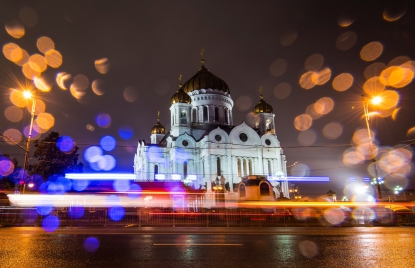 Cathedral of Christ the Saviour in Moscow. The church, originally built in the 19th century, was destroyed by the Communists in 1931 and rebuilt after the collapse of the Soviet Union. (AFP / Mladen Antonov)
Cathedral of Christ the Saviour in Moscow. The church, originally built in the 19th century, was destroyed by the Communists in 1931 and rebuilt after the collapse of the Soviet Union. (AFP / Mladen Antonov)I left in 1994 and went on to cover the Balkans and Eastern Europe. And then in 2003 I came back again for AFP, this time as chief photographer for Eastern Europe based in Moscow -- the job was just too interesting to pass up. I left in 2006, this time vowing that it was definitely the last time. It was just a karma thing, it wasn’t for me.
 A photo made on July 21, 2017 shows one of the seven Stalin's era skyscrapers lit by the sun following a heavy rain storm over Moscow. / (AFP / Mladen Antonov)
A photo made on July 21, 2017 shows one of the seven Stalin's era skyscrapers lit by the sun following a heavy rain storm over Moscow. / (AFP / Mladen Antonov)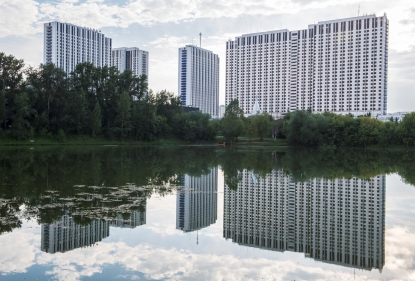 A photo taken on July 30, 2017 shows the Izmailovo Delta hotel in Moscow. (AFP / Mladen Antonov)
A photo taken on July 30, 2017 shows the Izmailovo Delta hotel in Moscow. (AFP / Mladen Antonov)
I went on to work for five years as chief international photo editor in Paris and then chief photo editor in North America in Washington. And then…. well, I got another offer that I couldn’t refuse -- this time to come back as a special correspondent to lay the groundwork ahead of the World Cup in 2018. So here I am again.
I have to say that even though each time I say ‘No more Russia,’ and each time I don’t regret being here. This time is no different.
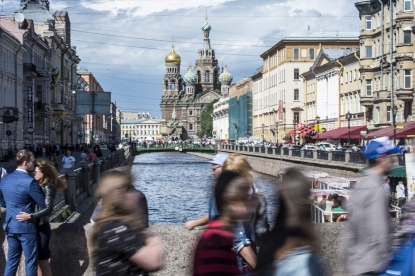 A view shows the Church of the Savior on Spilled Blood in central Saint Petersburg on June 19, 2017.
(AFP / Mladen Antonov)
A view shows the Church of the Savior on Spilled Blood in central Saint Petersburg on June 19, 2017.
(AFP / Mladen Antonov)The place I’ve come back to has nothing to do with the place I left 10 years ago, and a distant memory of the place I left in 1994.
 A young woman takes a selfie picture with her mobile phone at the Muzeon park of arts in Moscow on July 19, 2017. (AFP / Mladen Antonov)
A young woman takes a selfie picture with her mobile phone at the Muzeon park of arts in Moscow on July 19, 2017. (AFP / Mladen Antonov)The most striking thing has been the young people. It’s a new generation of Russians. Ten years ago, the stereotypical image of teenagers was drunk kids with beer in their hands in the park. Now, even if you look for it, you can’t find it. Now they are in the park skateboarding, rollerblading, dancing. There are new faces, very open, very modern, it’s a different generation.
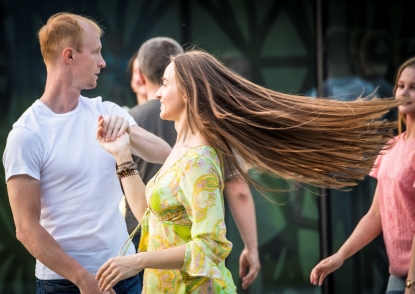 People take part in classical dances masterclass at Gorky Central Park of Culture and Leisure in Moscow on July 28, 2017 (AFP / Mladen Antonov)
People take part in classical dances masterclass at Gorky Central Park of Culture and Leisure in Moscow on July 28, 2017 (AFP / Mladen Antonov)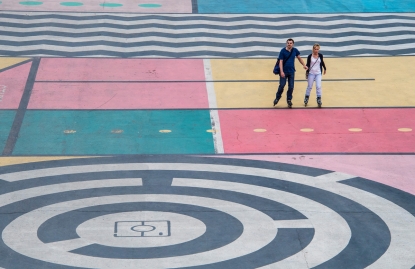 A couple rollerblades outside the Gorky Central Park of Culture and Leisure in Moscow on July 19, 2017. (AFP / Mladen Antonov)
A couple rollerblades outside the Gorky Central Park of Culture and Leisure in Moscow on July 19, 2017. (AFP / Mladen Antonov)
Of course for now I’ve spent most of my time in Moscow and like any large city in any country, Moscow is not Russia. But the difference has really been striking.
When you used to go to a park in Moscow, you would find elderly people. Now it’s mostly the young. They are with their skateboards, their rollerblades, they’re jogging, dancing, doing yoga. Part of it is that it's finally warm after a long, cold winter. But if you didn’t know where you were, it could be any Western country. Except that they’re even more wild with their appearance, painting their hair pink and yellow and green. And that the girls wear heels and makeup. In the US, the girls wear flip-flops and no makeup. But gone are the mini-skirts that were de rigueur before on female Muscovites. Now the unspoken uniform is skinny jeans.
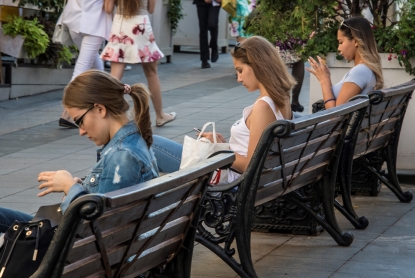 Young women on benches use their mobile phones on a pedestrian street in downtown Moscow on July 31, 2017. (AFP / Mladen Antonov)
Young women on benches use their mobile phones on a pedestrian street in downtown Moscow on July 31, 2017. (AFP / Mladen Antonov)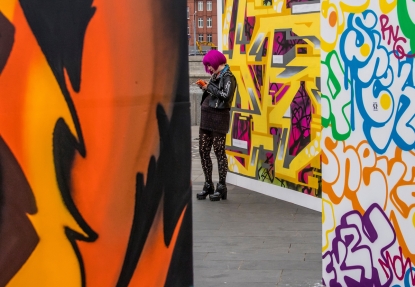 A young woman visits an open air exhibition on the banks of the Moskva River in Moscow on July 19, 2017. (AFP / Mladen Antonov)
A young woman visits an open air exhibition on the banks of the Moskva River in Moscow on July 19, 2017. (AFP / Mladen Antonov)
For a photographer, it’s been a dream. When I shot on the streets in my previous times here, each time there would be someone who would object, who would turn his or her back to you, who would tell you not to photograph. Now people don’t pay any attention to that, they don’t care. They just ignore you. Which is an ideal situation for a photographer -- you want to be ignored so you can just blend into the surroundings and record them.
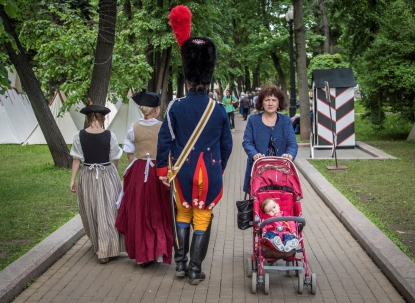 A woman with a baby trolley passes next to volunteers dressed in 1812 costumes during the Times and Epochs History Fair in downtown Moscow on June 8, 2017. (AFP / Mladen Antonov)
A woman with a baby trolley passes next to volunteers dressed in 1812 costumes during the Times and Epochs History Fair in downtown Moscow on June 8, 2017. (AFP / Mladen Antonov)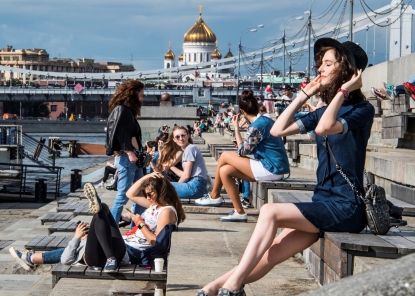 A woman poses as shw enjoys a sunny evening on the banks of the Moskva River at the Gorky Central Park of Culture and Leisure in Moscow on July 19, 2017. (AFP / Mladen Antonov)
A woman poses as shw enjoys a sunny evening on the banks of the Moskva River at the Gorky Central Park of Culture and Leisure in Moscow on July 19, 2017. (AFP / Mladen Antonov)
You can take photos in places where you couldn’t before, like the Moscow metro, or the GUM department store next to Red Square.
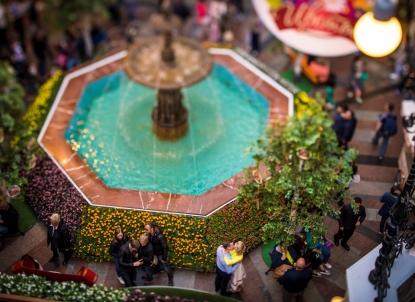 A picture taken with a tilt and shift lens shows near a fountain in the high-end GUM (State Department Store) shopping centre in Moscow on July 9, 2017. (AFP / Mladen Antonov)
A picture taken with a tilt and shift lens shows near a fountain in the high-end GUM (State Department Store) shopping centre in Moscow on July 9, 2017. (AFP / Mladen Antonov) A picture taken with a tilt and shift lens shows people walking in the high-end GUM (State Department Store) shopping centre in Moscow on July 9, 2017. (AFP / Mladen Antonov)
A picture taken with a tilt and shift lens shows people walking in the high-end GUM (State Department Store) shopping centre in Moscow on July 9, 2017. (AFP / Mladen Antonov)
You really feel the relaxed atmosphere in the Red Square. Before when you shot there, you were always ready for a hand on your shoulder and a request to stop taking pictures. Now noone cares. Even the tourists are more relaxed -- they’re lying on the pavement taking selfies.
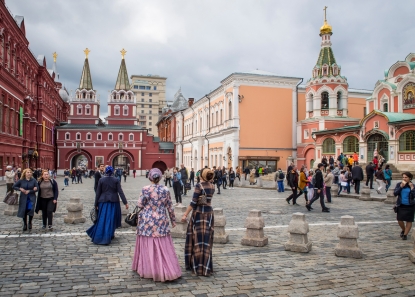 Tourists in traditional dresses walk towards Voskresenskiye Vorota (Resurrection Gates) leaving the Red Square in Moscow on July 9, 2017. (AFP / Mladen Antonov)
Tourists in traditional dresses walk towards Voskresenskiye Vorota (Resurrection Gates) leaving the Red Square in Moscow on July 9, 2017. (AFP / Mladen Antonov)Another striking thing is the patriotism and nationalism on display. The love of Mother Russia is everywhere. Everywhere you’re being pumped that Russia is the best. The Russian flag seems to be everywhere -- T-shirts, hoodies, souvenirs, magnets. I even saw one of my photos of Putin that I took 10 years ago on a magnet. One of the most popular T-shirts that I’ve seen is emblazoned with the phrase “We’ll defeat them.” It doesn’t say who the ‘them’ are.
 A picture taken on July 5, 2017 shows a souvenir shops offering among others cup a tin mug depicting Russian President Vladimir Putin and US President Donald Trump, in Moscow.
(AFP / Mladen Antonov)
A picture taken on July 5, 2017 shows a souvenir shops offering among others cup a tin mug depicting Russian President Vladimir Putin and US President Donald Trump, in Moscow.
(AFP / Mladen Antonov)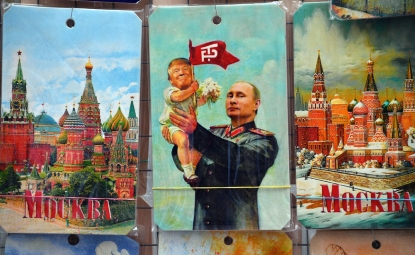 A picture taken on July 5, 2017 shows a souvenir kiosk offering among others a drawing depicting Russian President Vladimir Putin holding a baby with the face of US President Donald Trump, based upon a propaganda poster showing late soviet leader Joseph Stalin holding a baby, in Moscow.
(AFP / Mladen Antonov)
A picture taken on July 5, 2017 shows a souvenir kiosk offering among others a drawing depicting Russian President Vladimir Putin holding a baby with the face of US President Donald Trump, based upon a propaganda poster showing late soviet leader Joseph Stalin holding a baby, in Moscow.
(AFP / Mladen Antonov)
The news on television has changed as well. It seems that most of the news bulletins are about what Putin did or say and how bad Ukraine is. Then there is some local news. But very little international news.
 Protesters hold posters reading 'Corruption steals the future' and 'Miserable cowardly thief' during an unauthorized opposition rally in central Moscow on June 12, 2017.
(AFP / Mladen Antonov)
Protesters hold posters reading 'Corruption steals the future' and 'Miserable cowardly thief' during an unauthorized opposition rally in central Moscow on June 12, 2017.
(AFP / Mladen Antonov) Young protesters take part in an unauthorized opposition rally on Tverskaya street in central Moscow on June 12, 2017.
(AFP / Mladen Antonov)
Young protesters take part in an unauthorized opposition rally on Tverskaya street in central Moscow on June 12, 2017.
(AFP / Mladen Antonov)
Before you would have news from around the world. But now it’s very Russia-centric.
 A protester with tape covering her mouth takes part in the March for Free Internet in central Moscow on July 23, 2017. (AFP / Mladen Antonov)
A protester with tape covering her mouth takes part in the March for Free Internet in central Moscow on July 23, 2017. (AFP / Mladen Antonov)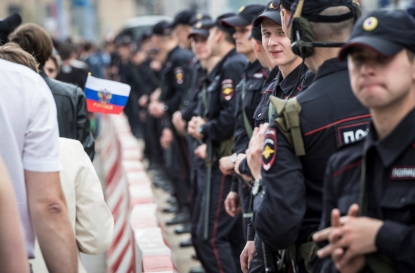 Policemen stand in line at the entrance to Tverskaya street as an unauthorized opposition rally takes place in central Moscow on June 12, 2017.
(AFP / Mladen Antonov)
Policemen stand in line at the entrance to Tverskaya street as an unauthorized opposition rally takes place in central Moscow on June 12, 2017.
(AFP / Mladen Antonov)
There are also hundreds of open-air cafes, so people are outside much more. And the service industry is amazing. Ikea here is open until 2 o’clock in the morning. I bought my sofa at 1 am and it was delivered mid-day the following day.
Leasing a car here took me two phone conversations, three emails and a visit to the place to pick up the car. I gave my credit card, showed my passport, signed two documents and that was it. In America I had to sign more than a dozen agreements.
 A photo made on July 21, 2017, shows a car passing trough a puddle on Moscow's Garden Ring following heavy rains over Moscow. (AFP / Mladen Antonov)
A photo made on July 21, 2017, shows a car passing trough a puddle on Moscow's Garden Ring following heavy rains over Moscow. (AFP / Mladen Antonov)New York is known as the city that never sleeps, but Moscow is a contender for the spot. So many stores are open 24 hours. You can buy a refrigerator or a washing machine at 4 am. The delivery system is extremely well developed and fast and efficient, because so many people are buying things online.
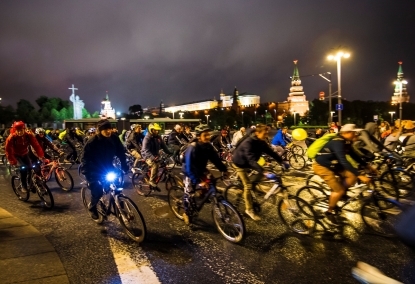 People ride bycicles in front of the Kremlin during the annual night velo parade cycling event gathering thousands of enthusiasts on the streets of Moscow on July 8, 2017. (AFP / Mladen Antonov)
People ride bycicles in front of the Kremlin during the annual night velo parade cycling event gathering thousands of enthusiasts on the streets of Moscow on July 8, 2017. (AFP / Mladen Antonov)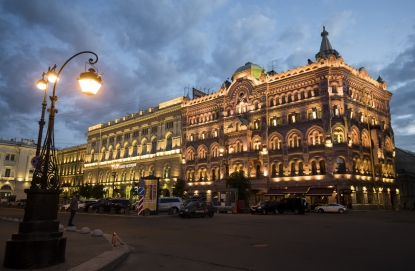 Illuminated buildings are seen in the early hours of June 20, 2017 in Saint Petersburg. (AFP / Mladen Antonov)
Illuminated buildings are seen in the early hours of June 20, 2017 in Saint Petersburg. (AFP / Mladen Antonov)
But despite all the changes you get an old Soviet whiff every once in awhile. Foreigners used to have to register with the authorities within a week of arriving. Now you have 24 hours. For some reason, they’ve changed custom regulations so that if you want to import your furniture, you have to pay a tax that’s determined by its weight. So basically you no longer import anything, you just buy everything here.
I have to say that I’m really enjoying being here. For one, I’m shooting again. For the past 10 years I’ve been mostly stuck at the office, so it feels really nice to be out and about doing what I love. It’s like a genie being let out of the bottle. And it’s very photogenic here, there are lots of things to photograph.
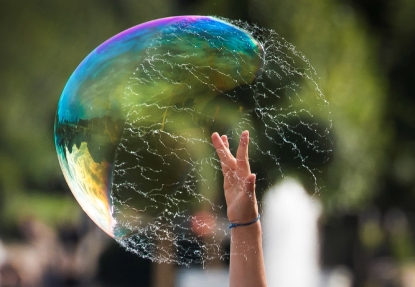 A boy bursts a soap-bubble at Gorky Park in Moscow on July 19, 2017. (AFP / Mladen Antonov)
A boy bursts a soap-bubble at Gorky Park in Moscow on July 19, 2017. (AFP / Mladen Antonov) This photo taken on June 25, 2017 shows the domes of Smolny Orthodox Cathedral reflected on a nearby building in St.Petersburg. (AFP / Mladen Antonov)
This photo taken on June 25, 2017 shows the domes of Smolny Orthodox Cathedral reflected on a nearby building in St.Petersburg. (AFP / Mladen Antonov)
Plus, once again, the job is really interesting. I am supposed to lay the groundwork for our coverage of the World Cup in 2018. A lot of that involves logistics. I will be visiting all the host cities, visiting hotels, seeing what the transportation system is like, to get an idea of what kind of arrangements we will have to make to cover the tournament well. But it also involves photographing these places. Providing a record of what they’re like. For the time being, I’ve spent most of my time in Moscow and of course the sprawling capital does not represent provincial Russia. So I’m very excited to go out into the country and discover it.
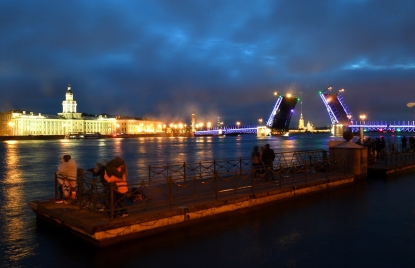 People standing on an embankment of the Neva River enjoy a view of the Dvortsovy (Palace) Bridge connecting Dvortsovaya Square and the Vasilievsky island, which is opened for river traffic, in Saint Petersburg during the early hours of June 19, 2017. (AFP / Mladen Antonov)
People standing on an embankment of the Neva River enjoy a view of the Dvortsovy (Palace) Bridge connecting Dvortsovaya Square and the Vasilievsky island, which is opened for river traffic, in Saint Petersburg during the early hours of June 19, 2017. (AFP / Mladen Antonov) The sun sets behind the Kunstkamera at the embarkement of the Neva river in Saint Petersburg on June 21, 2017. (AFP / Mladen Antonov)
The sun sets behind the Kunstkamera at the embarkement of the Neva river in Saint Petersburg on June 21, 2017. (AFP / Mladen Antonov)
It’s a good time to be here again. I feel like I’m in the right place at the right time. And that’ll be it for me and Russia. I swear.
This blog was written with Yana Dlugy in Paris.
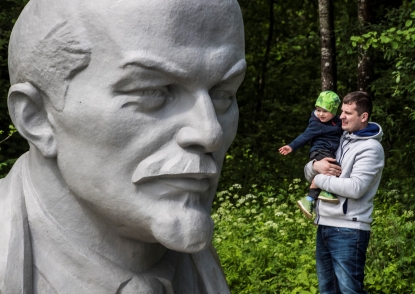 A photo taken on June 27, 2017 shows a geant bust of the founder of the Soviet Union Vladimir Lenin installed in the park of Lenin's Sharash Museum in Razliv, outside of Saint Petersburg.
(AFP / Mladen Antonov)
A photo taken on June 27, 2017 shows a geant bust of the founder of the Soviet Union Vladimir Lenin installed in the park of Lenin's Sharash Museum in Razliv, outside of Saint Petersburg.
(AFP / Mladen Antonov)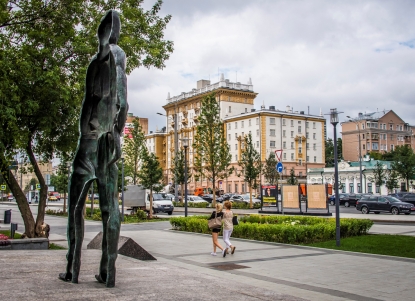 A general view taken on July 31, 2017 shows the US embassy building in Moscow.
(AFP / Mladen Antonov)
A general view taken on July 31, 2017 shows the US embassy building in Moscow.
(AFP / Mladen Antonov)





